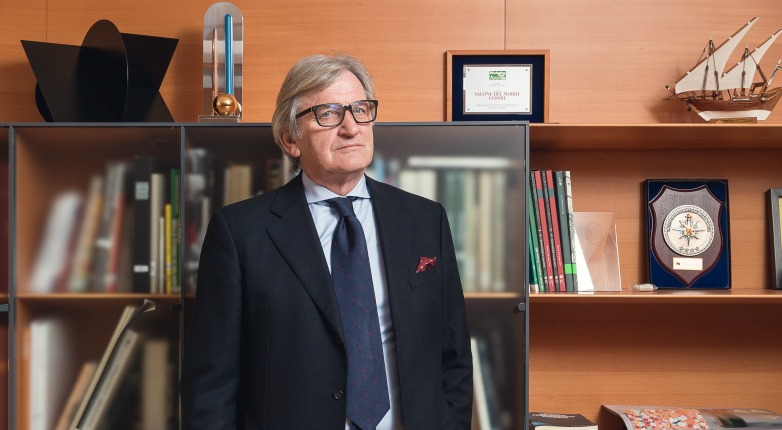Roberto Snaidero isn’t just the newly installed president of a gargantuan design convention: he is, in effect, the leader of a small, ephemeral, and extremely wealthy country. More than 300,000 people will descend on Milan this month for Salone del Mobile—the world’s most important contemporary design fair—piling into the vast exhibition compound in the Fiera Milano Fairgrounds of Rho, the de facto capital of Snaidero’s nation-state. His influence also extends into the city proper, where hundreds more Salone-related goings-on will fill up visitors’ calendars during the fair’s weeklong run. With Salone’s 54-year history, countless millions of dollars in sales, and Italy’s still-fragile economy all hanging in the balance, Snaidero now holds the keys to a very important kingdom. He was, he says, to the manner born. “I come from a family that has always lived within the design world,” he explains, “so it was natural for me to continue on this path.”
The 67-year-old Snaidero was born in the northern Italian province of Udine, where his father Rino founded one of Italy’s largest producers of fitted kitchens. After taking a degree in economics at the Università degli Studi of Trieste, he began his career not with his family’s eponymous firm but with a manufacturer of skis and sportswear. His experience in the broader products marketplace subsequently helped him take the Snaidero brand out of the kitchen and into the building trade at large. In 1996, he founded Snaidero Engineering & Trading, a full-service contracting company for the specialty market. As Snaidero puts it, his business-world training and real-world expertise were “choices” that suited him to the role he took at the company, and they’ve combined perfectly with his taste for high-quality design.
Salone in particular, not just design, is very much in Snaidero’s blood. “My father was among the initiators and founders of Salone,” he says. The young Roberto visited the fair’s inaugural edition, in 1961. Since then, his relationship with the design fair has only deepened, and in 2008 he joined its board of advisors, the springboard to a presidency that began in October of last year. Looking back over the long sweep of the fair’s history, Snaidero sees a showcase that has “always had a particularity,” a distinctive alchemy not present in other global design functions. “Innovative design combined with the possibility of presenting events,” he says, has made for an “un-missable opportunity” that keeps bringing the fair’s nearly 2,500 exhibitors back year after year, decade after decade.
Accordingly, Snaidero isn’t planning on altering Salone’s basic chemistry. “We like to say ‘never change a winning team,’” he says. “Ideas are many, but we have to consider that we are not living in a climate of market growth.” Snaidero’s approach to the still-challenging economic terrain in Europe has been to make “emotional impact,” in addition to a showcase of Italian-made goods, a focus of the fair. On view for the duration of this year’s fair (April 14–19) special installations such as architect Michele De Lucchi’s “The Walk,” a creative meditation on the contemporary office environment (for more on De Lucchi, see page 140), and “Favilla,” an immersive lighting experience from designer Attilio Stocchi, offer viewers opportunities to connect with light in powerful and unusual ways. The fair, Snaidero says, is already “the ultimate global event in the field of furniture,” and like any good leader, he’s wary of overreach. Even with his newfound distinction as Salone’s sovereign, Snaidero seems to be ruling with a soft touch.

